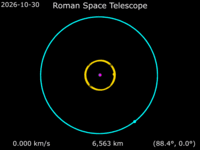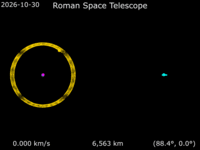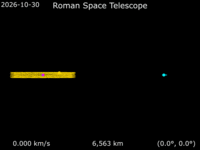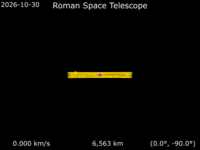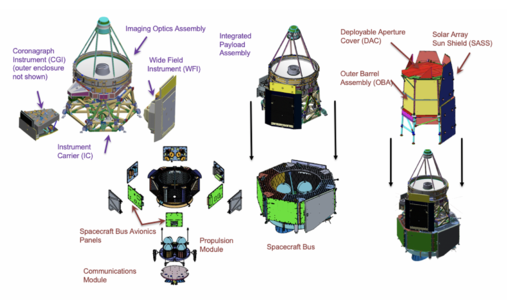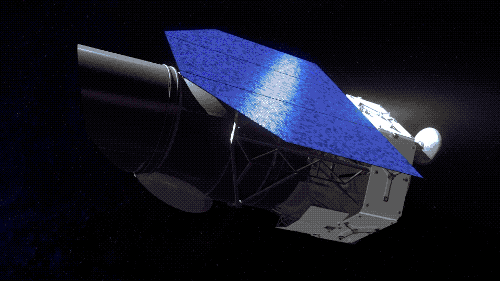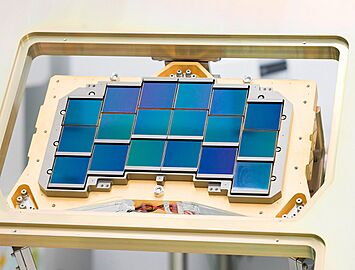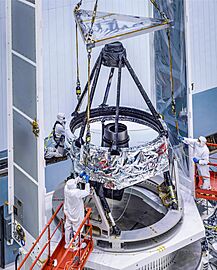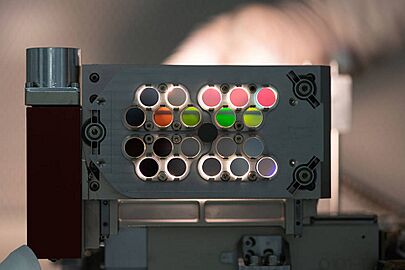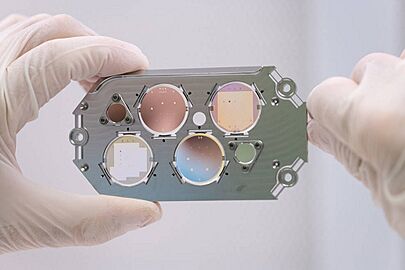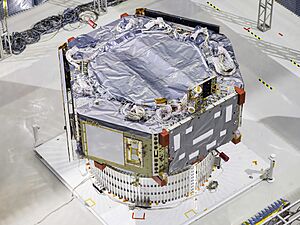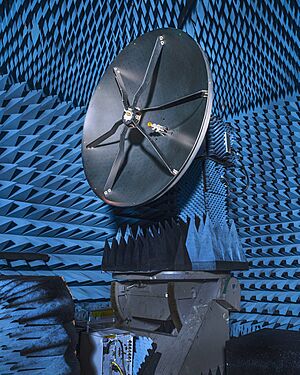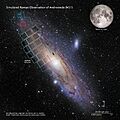Nancy Grace Roman Space Telescope facts for kids
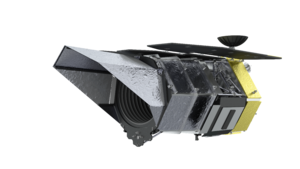
Rendered model of the Roman Space Telescope
|
|
| Names | Roman Roman Space Telescope (RST) Wide-Field Infrared Survey Telescope (WFIRST) Joint Dark Energy Mission (JDEM) |
|---|---|
| Mission type | Infrared space telescope |
| Operator | NASA / GSFC |
| Mission duration | 5 years (planned) |
| Spacecraft properties | |
| Manufacturer | NASA Goddard Space Flight Center |
| Launch mass | 4,166 kg (9,184 lb) |
| Dry mass | 4,059 kg (8,949 lb) |
| Payload mass | 2,191 kg (4,830 lb) (telescope & instruments) |
| Power | 2.5 kW |
| Start of mission | |
| Launch date | October 2026 (contracted) – May 2027 (commitment) |
| Rocket | Falcon Heavy |
| Launch site | Kennedy LC-39A |
| Contractor | SpaceX |
| Orbital parameters | |
| Reference system | Sun–Earth L2 orbit |
| Regime | Halo orbit |
| Perigee | 188,420 km (117,080 mi) |
| Apogee | 806,756 km (501,295 mi) |
| Main telescope | |
| Type | Three-mirror anastigmat |
| Diameter | 2.4 m (7.9 ft) |
| Focal ratio | f/7.9 |
| Wavelengths | 0.48–2.30 μm (Blue to Near-infrared) |
|
Large Strategic Science Missions
Astrophysics Division |
|
The Nancy Grace Roman Space Telescope, often called Roman or RST, is a special space telescope built by NASA. It is designed to study the universe using infrared light. The telescope is named after Nancy Grace Roman, who was a very important astronomer at NASA.
Roman is planned to launch by May 2027 and will orbit a special spot in space called the Sun–Earth L2 orbit. This spot is about 1.5 million kilometers (nearly a million miles) away from Earth, in the direction away from the Sun.
The telescope has a large mirror, about 2.4 meters (7.9 feet) wide. It carries two main science tools. One is the Wide-Field Instrument (WFI), a powerful camera with 300.8 megapixels. It can take very sharp pictures, similar to the Hubble Space Telescope, but it covers an area 100 times larger! The other tool is the Coronagraph Instrument (CGI). This instrument is designed to block out the bright light from stars. This allows it to see faint objects like planets orbiting those stars.
Roman's main goals are to search for planets outside our solar system using a method called gravitational microlensing. It will also study the history of the universe and how large structures in space grew. Scientists hope to learn more about dark energy, a mysterious force that makes the universe expand faster.
The idea for Roman was first suggested in 2010 as a top priority for astronomy. NASA approved its development in 2016. The telescope is set to launch on a Falcon Heavy rocket.
Contents
Building the Telescope
The design of the Roman Space Telescope has changed over time. It was first thought of as part of a project called the Joint Dark Energy Mission (JDEM). This was a partnership between NASA and the Department of Energy.
Early designs in 2011–2012 suggested a smaller telescope. It would have a 1.3-meter (4.3-foot) mirror and one instrument.
In 2012, NASA got an exciting offer. The National Reconnaissance Office (NRO) offered to donate two large telescopes. These telescopes were similar in size to the Hubble Space Telescope. They had a wider view, which was perfect for Roman's goals. This donation helped the project move forward.
The Roman telescope now includes a coronagraph. This special tool helps scientists take direct pictures of planets orbiting other stars.
Scientists considered different orbits for Roman. They decided on a halo orbit around the Sun-Earth Lagrange point L2. This orbit is great for stable observations and a good environment for the telescope.
The team at NASA's Goddard Space Flight Center in Greenbelt, Maryland, leads the project. In 2018, NASA signed a contract for a key part of the telescope, the Optical Telescope Assembly (OTA).
What Roman Will Study
The Roman Space Telescope has big goals for understanding the universe. It will help answer important questions about cosmology (the study of the universe) and exoplanets (planets outside our solar system).
Exploring Dark Energy
Roman will help scientists understand dark energy. This mysterious force is causing the universe to expand faster and faster. Roman will use three different ways to study dark energy:
- Baryon acoustic oscillations: Looking at patterns in how galaxies are spread out.
- Supernovae: Observing distant exploding stars.
- Weak gravitational lensing: Studying how gravity from large objects bends light from faraway galaxies.
Finding Exoplanets
Roman will search for many new exoplanets. This will help us learn how common solar systems like ours are. It will also look for planets in the cold, outer parts of other star systems. This research helps us understand if other planets could support life.
Roman uses a technique called gravitational microlensing. This method can find planets that are only a few times bigger than Earth's Moon. It can even find planets that float freely in space, not orbiting any star.
Other Discoveries
Roman will also allow other scientists to use its data for their own research. This means it could help answer many different questions about our galaxy and the universe.
The telescope's coronagraph will take the first direct pictures of planets around nearby stars. It will also study their light to learn what they are made of. Roman might even help detect primordial black holes, which are tiny black holes formed in the early universe.
Roman's Instruments
The Roman Space Telescope carries two main scientific instruments.
- WFI
- The Wide-Field Instrument (WFI) is a powerful camera. It takes pictures in visible and near-infrared light. It has 18 special detectors that work together to capture a very wide view of space. The WFI can also split light into different colors. This helps scientists learn about the objects it observes.
- CGI
- The Coronagraph Instrument (CGI) is designed to block out the bright light from stars. This allows it to see faint planets orbiting those stars. It uses special mirrors to achieve this. The CGI is a test for future telescopes that will take even better pictures of exoplanets.
Project History
On March 2, 2020, NASA officially approved Roman to move forward with its construction. The estimated cost for building and operating the telescope for five years was about $3.934 billion.
On May 20, 2020, NASA announced that the mission would be named the Nancy Grace Roman Space Telescope. This honored Nancy Grace Roman for her important work in astronomy.
The COVID-19 pandemic affected the telescope's development. NASA estimated an extra cost of about $400 million due to the pandemic's impact.
By September 29, 2021, Roman had passed a major review called the Critical Design Review (CDR). This meant its design was finalized and ready for building. The launch date was set for no later than May 2027.
On July 19, 2022, NASA announced that a Falcon Heavy rocket would launch Roman. The launch contract cost about $255 million.
In October 2024, the telescope successfully passed a major 'spin test'. This test checks how the telescope handles forces during launch.
In September 2024, the main body of the spacecraft, called the satellite bus, was mostly finished. In December 2024, the science instruments and mirror were successfully put together onto a special part called the "instrument carrier."
Funding and Support
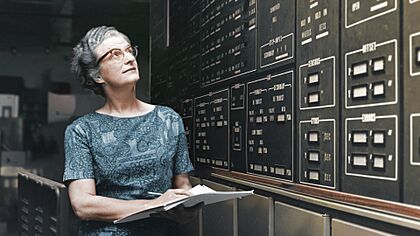
The Roman Space Telescope has received strong support from the U.S. Congress. In 2016, Congress provided more money than NASA asked for. This allowed the mission to officially become a project.
In 2018, the Trump administration suggested delaying funding for Roman. They said there were higher priorities for NASA. However, many astronomers disagreed. They pointed out that Roman was the top-priority space mission for the 2020s, as recommended by a major astronomy survey.
Congress supported Roman. In March 2018, they approved funding for the telescope. They stated that they "reject the cancellation of scientific priorities recommended by the National Academy of Sciences decadal survey process." This showed their commitment to the project.
In March 2019, the Trump administration again proposed cutting Roman's funding. However, NASA leaders indicated that Roman would be a very important mission after the James Webb Space Telescope was launched.
In November 2019, Roman completed another important review, the Preliminary Design Review (PDR). This confirmed the mission was on track for a 2025 launch date.
In April 2025, the second Trump administration proposed cutting Roman's funding again. This was part of larger proposed cuts to NASA's science budget. However, the project continued to move forward.
Team and Partners
The main team for the Roman project is at NASA's Goddard Space Flight Center in Greenbelt, Maryland. They manage the whole project and build the Wide-Field Instrument and the spacecraft. The Coronagraph Instrument is being built at NASA's Jet Propulsion Laboratory in Pasadena, California.
Scientists from other places also help with Roman. These include the Space Telescope Science Institute in Baltimore, Maryland, and the Infrared Processing and Analysis Center in Pasadena, California.
International Cooperation
Several international partners are helping NASA with Roman. These include the French space agency CNES, the European Space Agency (ESA), the Japan Aerospace Exploration Agency (JAXA), and the Max Planck Institute for Astronomy in Germany.
These partners provide different parts and scientific support for the mission. For example, Europe and Japan are helping with the coronagraph instrument. Germany is considering providing parts for the coronagraph's filters. Japan also proposed adding a special module to study polarized light.
Ground stations around the world will help communicate with Roman. These include a new NASA station in White Sands, the Misasa station in Japan, and ESA's New Norcia station in Australia.
Building Contracts
Many companies help build parts of Roman. In 2018, Ball Aerospace was chosen to build key parts for the Wide-Field Instrument. Teledyne Scientific and Imaging provides the special infrared detectors for the Wide-Field Instrument. In November 2018, Harris Corporation was awarded the contract for the Optical Telescope Assembly.
Images for kids
-
A simulated image of part of the Andromeda Galaxy
See also
 In Spanish: Telescopio espacial Nancy Grace Roman para niños
In Spanish: Telescopio espacial Nancy Grace Roman para niños
- Wide-field Infrared Survey Explorer
- James Webb Space Telescope
- Spitzer Space Telescope
- Xuntian
- Euclid - A European space telescope, also conducting a survey to study dark energy


